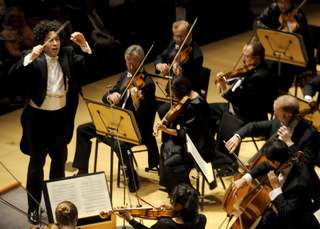|
Back
Dudamel Arrives in Orange County Orange County
Costa Mesa: Renée & Henry Segerstrom Concert Hall
03/05/2011 - & March 3, 4, 6, 2011 (Los Angeles)
Anton Webern: Five Pieces for Orchestra, op. 10
Toru Takemitsu: Requiem (for strings)
Anton Bruckner: Symphony No. 7 in E major
The Los Angeles Philharmonic Orchestra, Gustavo Dudamel (conductor) 
G. Dudamel & LA Phil. (© Jean Hsu/Courtesy of Philharmonic Society)
Although the Los Angeles Philharmonic visits its neighbors to the South every year, this concert had been billed as something extra special for a few reasons. Firstly, the Philharmonic Society of Orange County presented the concert as part of "JapanOC", a series of performances of pieces representing Japanese artists and composers. Secondly, this was Gustavo Dudamel’s first appearance with the LA Phil. in the Renée & Henry Segerstrom Concert Hall. Judging by the lack of empty seats and buzz in the audience, a combination of the two worked.
And so, the LA Phil. made the 50-minute trip down the freeway to pack Segerstrom Concert Hall on a beautiful Saturday afternoon. The result was clearly worth the wait.
The Los Angelenos offered the exact program that they were currently presenting at Disney Hall. It was performed with conviction and freshness. A chamber size group spaced out across the large stage presented the Webern. The Five Pieces were meticulously prepared and expertly spit out. They were followed by a moving performance of Toru Takemitsu’s Requiem. Both pieces can be considered a challenge to the typical classical audience. At intermission, one older gentleman was heard remarking to his companion, “That was the first time we had an experience like that!”
The Webern is now close to 100 years old and the Takemitsu, over 50. These aren’t the most experimental or avant-garde pieces that could be presented today, and in fact, they contain some exciting and even beautiful, accessible moments. The Takemitsu in particular is a mini-symphony in four parts with a scherzo and a recapitulation, all within 10 minutes. The Webern is even more efficient: a five-movement masterpiece in five minutes. This is music that is detached while mourning and complexly percussive when angry. The Takemitsu was particularly effective in this respect. After an angry and fierce scherzo section of the 10-minute work, the composer recaps the initial material that is a sad wash of sound from the large string orchestra, giving an air of resignation and inevitability.
If there is a problem with presenting these pieces it really is not the pieces themselves, but rather the context. The stage change after the Webern took significantly longer than the piece itself, and the Takemitsu, barely 10 minutes long, was followed by an early intermission. Furthermore, the Webern suffered from the overly bright acoustic of the hall with scooting box chairs intruding often. Left surrounded by empty space, where the audience retreats to its conversations and socializing, any impact is lost almost immediately.
The second half of the program featured Bruckner’s ode to his compositional hero, Richard Wagner. The massive 70-minute symphony opens with an echo of the German opera master’s nature motive from Das Rheingold. Indeed, the entire symphony is littered with inspirations from Wagner’s operas, including Bruckner’s take on The Ride of the Valkyries.
The LA Phil. played with confidence, elegance and awe-inspiring virtuosity. The sprawling lengths of the first two movements were handled masterfully by Maestro Dudamel who conducted, sans score, with anticipation and purpose, but not intrusion. Transitions were swift and flowing and the antiphonal placement of the violins on opposite sides of the front of the stage was masterfully utilized producing some exquisite duets and effects. The end of the Adagio second movement was a noble and touching elegy to Bruckner’s hero. Dudamel displayed the utmost care without resorting to preciousness.
The third and fourth movements brought out the best in the orchestra, with the young maestro marching on the podium as the orchestra sustained a feverish, driving rhythm. The textures were clear as could be and continued as such until the striking end of the movement, drawing an audible gasp from the audience. The piece concluded with even more energy as the brass surpassed their levels in the third movement and created an awesome sound that was broad and edgy, on the verge of losing control, but always beautiful and heroic.
It was a triumphant performance that showcased one of the most exciting orchestras in the country with the most talked about conductor in the country. If there are quibbles over logistics and contextual challenges, there should be no doubt that the LA Phil. delivered a brilliant afternoon of music that left the Orange County audience wanting more – preferably with Gustavo, from now on.
Matthew Martinez
|